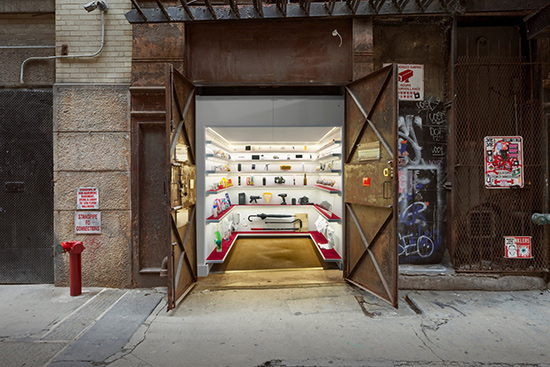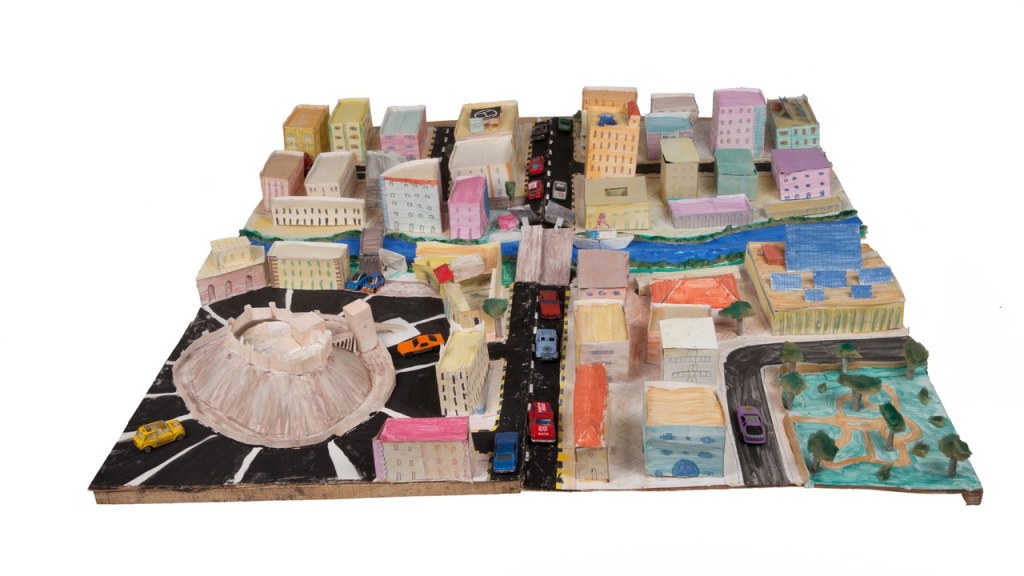电梯井中的博物馆

|
在这个位于纽约市中心无名小巷的六英尺乘六英尺的电梯井中,探索者们将发现一批正在委内瑞拉共享空间中销售的假冒产品,例如仿制的自制防毒面具,大多由中东人制作,还有可以实现宗教现代化的物件。(例如无谷圣餐饼、咒语计数器、安息日灯开关保险和LED焚香棒。) 为了防止人们误会,有一件事情我们得明确:摆放在这里的物品看似杂乱无章,但它们并非是无的放矢。此外,这个电梯井实际上是一个博物馆。 Mmuseumm由亚历克斯·卡尔曼和几位好友于2012年创建,同时会举办8到15个展览,每年共展出约150件精心挑选的物件。每个展览都有一个架子,上面展示着乍一看随机摆放的物件。卡尔曼说,这个空间在每年4月至11月对外开放,摆满了“能够洞悉我们所居住世界的本土物件。”他将Mmuseumm看作是“物品新闻”的载体。 他说的这句话到底是什么意思?他解释说:“[我正在]尝试通过物品来审视我们自身的本质以及所居住的整个世界。我认为这些物品所提供的视角能够让我们从内心出发,以真诚的态度近距离审视这个问题。” 馆长选择的地点在一定程度上也体现了这个视角。这位34岁的馆长自2014年一直就是Mmuseumm的唯一所有者,他说:“我认为,就像物品自身一样,它们在某种程度上十分低调,而且也不起眼,我希望这个空间也能够具备这些特质。我想要的是一个意想不到的场地。我希望人们需要花点时间才可以找到这个地点,这样,人们的好奇心就会被调动起来。”总而言之,这里的一切都不是随意摆放的,即便是博物馆颇为奇怪的名字亦是如此。 博物馆现任设施经理凯特·阿托尔说:“一开始的几个季度,我们将这里称之为museum(博物馆)。我们希望按其本来的面目来给它起名字。”最终,卡尔曼力求突出“Mmuseumm的荒诞性”,因此在museum的前面增加了字母m。为了对称,他又在名字的结尾加了另一个m。然而,卡尔曼说:“我不会去纠正其他人以及他们的各种念法。” 将形态与功能以如此无缝的形式结合起来是一项难得的壮举。然而在这里,这个理念是可行的,尤其是在谈到今年的展览时更是如此。例如,看起来像是随机摆放在其中一个架子上的15个热面包复制品实际上是对当前监狱系统的拷问,它讲述了一位男囚的故事,他被独自关在利克斯岛(Rikers Island)上,然后他决定在小卖部购买一些甜品来自杀。在吃了所有的甜品之后,他因为糖尿病而昏了过去,然后去世了。自此以后,小卖部不再出售热面包。 卡尔曼在介绍其理念时表示:“最终,展览真的必需具备实质性的内容。”他觉得,那些不同寻常的空间(这个地方是他偶然发现的,他的办公室就在楼上,房东把废弃的电梯井让给了他)只能讲述他希望分享的故事,但并非是故事本身。他在谈到货梯时表示:“不能只是徒有其表,整个展览的不同寻常之处在一定程度上以自身的美学反映了这些非常传统的博物馆元素:架子上的红色天鹅绒、白色的模具。说到博物馆体验,我们遵循了一定的规则,为的是打破很多规则。” 很明显,卡尔曼认为他的理念可以在曼哈顿和这个狭小的电梯井空间之外引发共鸣。这一点他并没有错:此前在Mmuseumm展出的两件作品如今正在全球旅行。“萨拉·博曼的壁橱”(2015)再现了卡尔曼祖母84岁去世之时的壁橱,曾经于2017年在纽约大都会艺术博物馆展出,并于2018年搬至洛杉矶的史克博尔文化中心(Skirball Cultural Center),如今已经成为了费城独立广场美国犹太历史国家博物馆门外象征自由与独立的公共纪念物。2016年在Mmuseumm首次展出的“我的阿勒颇”是一个4英尺乘4英尺的叙利亚城纸质模型,源于战争期间14岁男孩默罕默德·酋塔西的想象。该作品随后现身于史克博尔文化中心(2017年)和伦敦的维多利亚与阿尔伯特博物馆(2018年),如今正在斯德哥尔摩的ArkDes博物馆展出。 |
Inside a six-by-six-foot elevator shaft in a nondescript alley in downtown New York City, explorers will find a bunch of counterfeit products currently being sold in Venezuela sharing space with facsimiles of homemade gas masks created by, mostly, Middle Easterners, alongside gadgets seeking to modernize religion. (Think gluten-free Communion wafers, a mantra counter, a safe-for-the-Sabbath light switch, and LED incense sticks.) Lest you be confused, let’s make one thing clear: The seemingly haphazard collection of objects is meant to be here. Also, the elevator shaft is actually a museum. Founded by Alex Kalman and a few friends back in 2012, Mmuseumm displays between eight and 15 exhibitions simultaneously, collectively showcasing about 150 curated items annually. Each exhibit consists of a shelf parading a slew of at-first-glance random objects. Open every year from April through November, the space is “filled with vernacular objects that provide insight into the world that we’re living in,” says Kalman, who sees Mmuseumm as a purveyor of “object journalism.” What, exactly, does he mean by that? “[I am] trying to look at who we are and the world that we’re living in through objects,” he explains, “believing they provide a very intimate, visceral, honest perspective.” Part of that perspective is manifested through the curator’s chosen venue. “I think that, like the objects themselves, which are in some way kind of humble—[they] are things that don’t call out for our attention—I wanted the space to also be that,” says the 34-year-old, who has been the sole owner of Mmuseumm since 2014. “I wanted an unexpected location. I wanted you to have to kind of find it, and in doing so, you’d already get into the mindset of being curious.” In essence, nothing here is random—not even the museum’s fairly odd name. “The first couple of seasons we were called Museum,” says Kate Athol, the current facilities manager. “We wanted to call the thing what it is.” Kalman eventually sought to highlight “the absurdity of what Mmuseumm is” and so added an “m” at the beginning of the name. For symmetry, he opted to add another one at the end of it. But, Kalman says, “I don’t correct other people and their various pronunciations.” It’s a rare and incredible feat for form and function to coalesce so seamlessly. But here, the concept works—especially when analyzed against the backdrop of this year’s exhibitions. The 15 hot bun reproductions that appear to be placed at random on one of the shelves, for example, are actually a commentary on the current prison system, recounting the story of a man locked in solitary on Rikers Island and his decision to purchase the treats at the commissary as a way to commit suicide. Consuming them all at once, he went into a diabetic coma and passed. Hot buns are no longer sold at the commissary. “Ultimately, there really does need to be substance,” Kalman says of his concept. He feels that the unusual space—which he found serendipitously; his office was upstairs, and the landlord offered him the shaft when no longer in use—only contributes to telling the stories he wishes to share, but isn’t the story itself. “It can’t just be style,” he says of the freight elevator. “The unconventionality of the whole thing in some ways refers to these very traditional museum elements within its aesthetic: the red velvet on the shelves, the white molding. We’re following some rules so we can break many others when it comes to what a museum experience can be.” Clearly, Kalman believes his concept could resonate both outside Manhattan and outside a tiny elevator shaft. And he isn’t wrong: Two of the exhibits previously mounted at Mmuseumm are now traveling the world. “Sarah Berman’s Closet” (2015)—a reproduction of Kalman’s grandmother’s closet at the time of her passing, when she was 84—was on display at New York’s Metropolitan Museum of Art in 2017, moved to the Skirball Cultural Center in Los Angeles in 2018, and is currently a public monument to freedom and independence outside the National Museum of American Jewish History at Philadelphia’s Independence Mall. “My Aleppo,” which debuted at Mmuseumm in 2016, is a four-by-four-foot paper model of the Syrian city as imagined by Mohammed Qutaish, a 14-year-old boy, during the war. It traveled to the Skirball Cultural Center (2017), the Victoria and Albert Museum in London (2018), and is currently on display at ArkDes, in Stockholm. |

|
卡尔曼说:“对我来说,Mmuseumm是一个实验这种叙事手法的场地。在这里展出之后,我们会举办展品巡展活动。”这些海外展出获得的费用,Mmuseumm建议的4美元捐赠费以及一系列来自于个人的捐赠为这个非营利性博物馆提供了财力支持。此外,离该电梯井仅有数步之遥的地方,参观者可以在Mmuseumm Alley这个小礼品店购买零食、咖啡、纪念品和限量收藏品。 阿托尔称,每年有数千名参观者到访Mmuseumm,他们有的住在这个地区,有的是上班路过,有的则是从新闻和旅游指南中看到了这则新闻,还有的则属于狂热的粉丝,他们每年都会定期长途跋涉赶来参观当年的展览。馆长说,到了这里之后,“人们似乎异常感动,有一位参观者说,他们喜爱这里的真正原因在于,博物馆不会去固化他们的想法,而是给他们自由的思考空间。” 当然,卡尔曼希望以一种意料之中的意外方式来扩大其项目的规模,从而提升该项目的反响。他在谈论未来计划时说:“这个方案最吸引我的地方在于,它不是将展览场地扩大,而是将其打造为一个由众多小型场地组成的展览网络。这是一个去中心化的博物馆,其中涵盖设在全球其他国家的场地。” 他说,毕竟,“常规性的做法真的很无聊。”(财富中文网) 译者:冯丰 审校:夏林 |
“Mmuseumm is a place for me to experiment in this form of storytelling,” Kalman says. “After being exhibited here, we could tour the exhibitions.” Fees from these foreign shows, a suggested $4 contribution at Mmuseumm, and a series of donations from private individuals financially support the destination, which is run as a nonprofit. Also, just a few feet away from the shaft, visitors can purchase small bites, coffee, souvenirs, and limited-edition collectibles at Mmuseumm Alley, a tiny gift shop. According to Athol, the tens of thousands of folks who visit Mmuseumm each year either live in the area, walk by on their way to work, read about it in the news or guidebooks, or are ardent fans that make an annual pilgrimage to check out the year’s exhibitions on a regular basis. Upon entering the premises, “people seem to be incredibly moved,” the curator says. “One person said that what they really love about it is, it doesn’t tell them what to think, but that thinking is what they should be doing.” Of course, Kalman hopes to replicate that kind of reaction by expanding the scope of his project in—unsurprisingly—unexpected ways. “What attracts me most,” he says when queried about future plans, “is expanding not as one larger space but as this network of smaller locations. Kind of a decentralized museum that will include locations in other countries in the world.” After all, he says, “regular really bores me.” |













